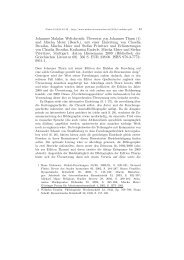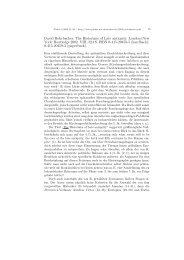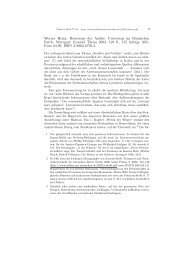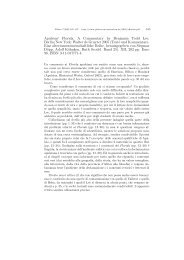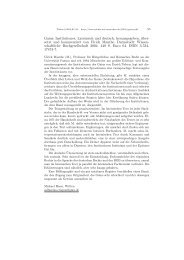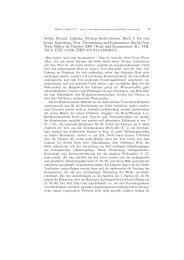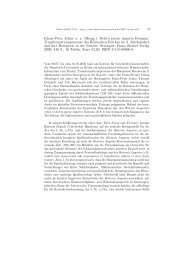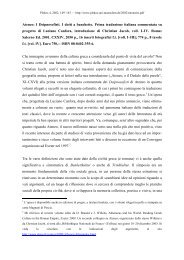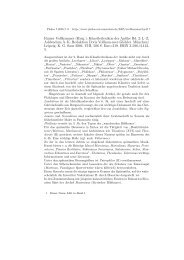Achim Lichtenberger: Kulte und Kultur der Dekapolis ... - Plekos
Achim Lichtenberger: Kulte und Kultur der Dekapolis ... - Plekos
Achim Lichtenberger: Kulte und Kultur der Dekapolis ... - Plekos
You also want an ePaper? Increase the reach of your titles
YUMPU automatically turns print PDFs into web optimized ePapers that Google loves.
<strong>Plekos</strong> 6,2004,55–59 – http://www.plekos.uni-muenchen.de/2004/rlichtenberger.pdf 55<br />
<strong>Achim</strong> <strong>Lichtenberger</strong>: <strong>Kulte</strong> <strong>und</strong> <strong>Kultur</strong> <strong>der</strong> <strong>Dekapolis</strong>. Untersuchungen<br />
zu numismatischen, archäologischen <strong>und</strong> epigraphischen<br />
Zeugnissen. Abhandlungen des Deutschen Palästina-Vereins, Band<br />
29. Wiesbaden: Harrassowitz Verlag, 2003. xi + 455 pp, 22 plates<br />
+ 1 loose map. Euro 138. ISBN: 3-447-04806-9.<br />
The book here <strong>und</strong>er discussion, a doctoral thesis from the Eberhard-Karls-<br />
Universität at Tübingen, is the first ever comprehensive overview of religious<br />
life in the cities of the Syrian Decapolis as a whole. It presents an “Untersuchung<br />
<strong>der</strong> <strong>Kulte</strong> <strong>und</strong> Heiligtümer <strong>der</strong> <strong>Dekapolis</strong>-Städte in römischer Zeit vor<br />
dem Hintergr<strong>und</strong> lokaler Traditionen <strong>und</strong> römisch-hellenistischer <strong>Kultur</strong>” (1).<br />
It manages to fill an obvious gap and is an extremely welcome contribution<br />
to the study of the religious history of the Near East in the Graeco-Roman<br />
period. Until now studies were either on the cults of a particular city, or on one<br />
category of source material only. 1 There has been plenty of discussion of what<br />
actually was ‘the Decapolis’, but it seems at least to be clear that it was not<br />
created in the Hellenistic period as a league as such. Hard evidence that ‘the<br />
Decapolis’ referred to a specific form of organisation (within the province of Syria)<br />
does not appear before the end of the first century AD. After the creation<br />
of Arabia in AD 106, when the various cities were divided over three different<br />
Roman provinces, the term can have had only geographical implications. 2<br />
It cannot be emphasised enough that most of our evidence for religion in<br />
the cities of the Decapolis dates to the second and third century AD, when the<br />
Decapolis as such had ceased to function as whatever sort of administrative<br />
unit it may at some point have been. 3 This is true both for the archaeological<br />
remains of the relevant cities, for the epigraphic and sculptural sources they<br />
reveal, and for the coins the cities issued. The numismatic evidence stands out<br />
because, in contrast to most of the other material, it came from a city as a<br />
collectivity. It could be argued that it is precisely the parallel evidence from<br />
1 The classic paper by H. Seyrig: Temples, cultes et souvenirs historiques de la<br />
Décapole. Syria 36, 1959, 60–78, is based mainly on coins and deals with five of<br />
the cities. Cf. C. Augé: Divinités et mythologies sur les monnaies de la Decapole.<br />
Le Monde de la Bible 22, 1982, 43–47. For a recent overview of the Decapolis,<br />
with further references to individual case studies, see A. Hoffmann and S. Kerner<br />
(eds.): Gadara – Gerasa <strong>und</strong> die <strong>Dekapolis</strong>. Mainz 2002.<br />
2 Cf. “<strong>Dekapolis</strong> bezeichnete somit niemals einen freien Städteb<strong>und</strong>, son<strong>der</strong>n immer<br />
nur eine Verwaltungseinheit <strong>der</strong> römischen Provinz Syria. In diesem Sinn kann<br />
er von Pompeius bis 106 n. Chr. verwendet werden, wobei <strong>der</strong> genaue Zeitpunkt<br />
<strong>der</strong> Bezeichnung als <strong>Dekapolis</strong> nicht sicher zu ermitteln ist” (20).<br />
3 See T. Kaizer: Some remarks about religious life in the Decapolis. Hallesche<br />
Beiträge zur Orientwissenschaft 36, 2004 (forthcoming), a paper written in anticipation<br />
of <strong>Lichtenberger</strong>’s overview.
56 Ted Kaizer<br />
the coins issued by the various Decapolis cities in the second and third centuries<br />
that contributes most to our impression of a continuing cultural cohesion<br />
between the former members of the unit, and thus makes a study of religion in<br />
the Decapolis as a whole a legitimate <strong>und</strong>ertaking.<br />
From that point of view it is <strong>und</strong>erstandable that <strong>Lichtenberger</strong> makes the<br />
numismatic evidence “die Quellenbasis <strong>der</strong> Untersuchung” (1). He starts from<br />
the principle that depictions on coins are relevant for the city which issues<br />
them, and “dass die Motive bewusst von Bürgern <strong>der</strong> Polis ausgewählt wurden<br />
<strong>und</strong> . . . in einem direkten lokalgeschichtlichen Bezug zu <strong>der</strong> Stadt stehen” (1).<br />
When one is interested in a city as a collectivity, coinage is indeed more significant<br />
than individual dedications. Nevertheless, one ought to be aware that<br />
the evidence for cults on a city’s coinage does not provide us with a complete<br />
and impartial view of the various aspects of worship in that city, but presents<br />
a mere civic facade of religious life.<br />
It is of course unclear which cities actually belonged to the Decapolis, and<br />
this is not solely a mo<strong>der</strong>n problem. Pliny the El<strong>der</strong>, in his Natural History<br />
(5, 74), acknowledged that “the region was so called from the number of its<br />
towns, though not all writers keep to the same towns in the list”. The geographer<br />
Ptolemy, in the second century AD, grouped together eighteen cities<br />
as belonging to “Koile Syria and the Decapolis” (Geogr. 5, 14, 18), two terms<br />
which are both interpreted by <strong>Lichtenberger</strong> as originally “synonym mit <strong>der</strong><br />
administrativen Untereinheit <strong>der</strong> Provinz Syria” (19). 4 The longer list of cities<br />
which Ptolemy gives is the result of the latter’s confusion of “die späthellenistische<br />
Bezeichnung Koile Syrien mit einem späteren Begriff, <strong>der</strong> . . . das Gebiet<br />
zwischen Libanon <strong>und</strong> Antilibanon benennt” (16). The number eighteen is also<br />
often encountered in mo<strong>der</strong>n numismatic studies, dealing with the coinage of<br />
the Decapolis and of provincia Arabia. 5 Every choice of cities to be studied<br />
is, to a degree, ultimately arbitrary. But it is surprising that <strong>Lichtenberger</strong><br />
opts to include only nine of them in his overview. The nine are the “westlichen<br />
<strong>Dekapolis</strong>-Städte . . . , die mit ihren Stadtterritorien ein zusammenhängendes<br />
Gebiet bilden” (20): Hippos, Dion, Abila, Gadara and Capitolias in the north,<br />
Scythopolis and Pella in the Jordan valley, and Gerasa and Philadelphia in the<br />
south. <strong>Lichtenberger</strong>’s Enneapolis excludes those places located further north-<br />
4 Cf. “Denn <strong>Dekapolis</strong> <strong>und</strong> Koile Syrien bezeichneten tatsächlich eine Zeit lang<br />
dasselbe Gebiet, <strong>und</strong> es ist anzunehmen, dass die <strong>Dekapolis</strong> aus <strong>der</strong> Strategie<br />
Koile Syrien, die 47 v. Chr. an Herodes gegeben wurde, hervorgegangen ist” (16).<br />
5 The standard collection is by A. Spijkerman: The Coins of the Decapolis and<br />
Provincia Arabia, ed. by M. Piccirillo. Jerusalem 1978. Cf. C. Augé: La place<br />
des monnaies de Décapole et d’Arabie dans la numismatique du Proche-Orient<br />
à l’époque romaine, in id. and F. Duyrat (eds.): Les monnayages syriens. Quel<br />
apport pour l’histoire du Proche-Orient hellénistique et romain? Beirut 2002,<br />
153–166.
<strong>Achim</strong> <strong>Lichtenberger</strong>: <strong>Kulte</strong> <strong>und</strong> <strong>Kultur</strong> <strong>der</strong> <strong>Dekapolis</strong>. 57<br />
east, such as Kanatha and Damascus (mentioned both by Pliny and by Ptolemy),<br />
“die räumlich, aber auch kulturell von den an<strong>der</strong>en getrennt waren” (20),<br />
but also Adra’a (in Ptolemy’s list), situated immediately east of Capitolia and<br />
Abila. Especially inclusion of the coinage from Adra’a, which in the second<br />
century depicts a betyl with accompanying inscription referring to “Dusares,<br />
god of the Adraènoi” 6 , could have put the evidence from the other places in<br />
perspective, e.g. an altar dedicated to this deity (in Greek) at Hippos (42–<br />
43), and the intriguing attestation of the cult of a so-called ‘Arab deity’ (����<br />
���������) at Gerasa (221–225). The remarks made thus far are not meant<br />
to be picky, but they are made because the exclusion of those sites whose evidence<br />
reveals different spheres of influence has assisted in bringing out not only<br />
a cultural cohesion between the Decapolis cities, but also common origins of<br />
their main cults. If the sources from other cities, which in the Roman period<br />
appeared at least in some lists relating to the Decapolis, are less consonant<br />
with an overall unequivocal thesis and complicate matters only further, so be<br />
it. Cultural bor<strong>der</strong>s and separations within the wi<strong>der</strong> region of the Near East<br />
were maybe not as fixed as we would sometimes like them to have been.<br />
This criticism does not diminish my appreciation of the learning which went<br />
into this book, and of the exhaustive discussion of the sources. The introduction<br />
sets the tone, by giving full details and references as regards the ancient<br />
sources on the Decapolis. The main body of the work consists of two parts. The<br />
largest one (‘Analytische Materialvorlage’) is an encyclopedic catalogue of the<br />
evidence for religion in the nine cities which are dealt with. Each city is introduced<br />
by a topographical and historical overview, followed by a presentation<br />
and discussion of the gods and sanctuaries which are depicted on that city’s<br />
coinage (in chronological or<strong>der</strong>). A similar section then follows on the gods and<br />
sanctuaries according to non-numismatic evidence, starting with those deities<br />
who also appear on the coins. The other part (‘Auswertung’) is divided in<br />
three sections, on gods, sanctuaries and cities (including their ‘Selbstdarstellung’<br />
with respect to the Graeco-Roman world at large). A concluding chapter<br />
is followed by a long bibliography, five indices, maps and plans of the Decapolis<br />
cities, and splendid reproductions of the variety of coins discussed. A fold-out<br />
map of the region is attached. Throughout the book, a smaller letter type is<br />
applied to designate the detailed argumentation that could interrupt the flow<br />
of reading.<br />
The most important thesis of the book is that the divine worlds of the nine<br />
Decapolis cities “massiv von phönikischen <strong>Kulte</strong>n geprägt waren” (357), and<br />
that this Phoenician influence goes back at least to the Hellenistic period. 7 It is<br />
6 Spijkerman, The Coins of the Decapolis, n os 1–3.<br />
7 It is interesting to see that not too long ago a similar claim was made with<br />
regard to the core of the divine world of Palmyra, by G. Garbini: Gli dèi<br />
fenici di Palmira. Atti della Accademia Nazionale dei Lincei, Rendiconti ser.
58 Ted Kaizer<br />
also argued, in contrast, that the so-called ‘Arab’ nature of many of the cults of<br />
the Decapolis is not supported by ancient sources. <strong>Lichtenberger</strong> is particularly<br />
good in distinguishing different ‘types’ of a deity, as appearing on coins, and<br />
he explains them in terms of different religious traditions, rather than as mere<br />
alternatives of representation. Hence the co-existence of the various forms of<br />
Zeus in the Decapolis cities goes back to the introduction of the main god of the<br />
Seleucids, Zeus Olympios, into a divine world where he is worshipped alongside<br />
local gods who are also – thanks to interpretatio Graeca – called Zeus: “Gerade<br />
das Verhältnis von interpretatio Graeca zu nicht-synkretistischen Gottheiten<br />
zeigt, dass die Städte zutiefst vor<strong>der</strong>orientalisch geprägt <strong>und</strong> nur an <strong>der</strong> Oberfläche<br />
– die allerdings das Bild prägte – hellenisiert waren” (331).<br />
A new division of the gods worshipped in the Decapolis according to their<br />
origins is a major step, but it does not say very much about the contemporary<br />
meaning attached to the cults in the second and third century AD. 8 And even<br />
about the origins one cannot always be certain. In the Roman Near East, the<br />
goddess Leukothea is especially attested in the region of the Hermon and Tyr.<br />
But does that make the Leukothea who received a cult in Gerasa and near Scythopolis<br />
‘Phoenician’? According to Cicero (nat. deor. 3, 39), a goddess with<br />
that name was worshipped ‘throughout the whole of Greece’ (cuncta Graecia).<br />
As regards Pella, <strong>Lichtenberger</strong> suggests that the Phoenician god Eshmun is<br />
portrayed on the city’s coins. It is clear that the relevant figure on the coins<br />
is not depicted in a standard Graeco-Roman fashion, and it is <strong>und</strong>erstandable<br />
that he is explained as an ‘Oriental’ or ‘indigenous’ god. But identification<br />
with the healing god who is known above all from his sanctuary outside Sidon,<br />
where he was identified in Classical times with Asclepius, rests not on an accompanying<br />
inscription, but only on interpretation of motives which were not<br />
confined to Eshmun. Finally, the appearance of Heracles and Dionysos figures in<br />
the Decapolis is not necessarily evidence for “die Bedeutung <strong>der</strong> jugendlichen<br />
Gottheiten” which leads to “<strong>der</strong> Entdeckung <strong>der</strong> tiefgreifenden phönikischen<br />
Prägung <strong>der</strong> Städte” (357). Some of the main deities can indeed be explained<br />
as being ‘Phoenician’ in origin (e. g. Melqart, but it ought to be stressed that<br />
he is not worshipped <strong>und</strong>er that name in the Decapolis), but even then it cannot<br />
be automatically concluded that ‘Phoenicians’ fo<strong>und</strong>ed or settled the cities<br />
of the Decapolis. 9 Divine names were not restricted to one ethnic or cultural<br />
9, vol. 9, 1998, 23–37. For a different interpretation of that material, see T.<br />
Kaizer: The Religious Life of Palmyra. Stuttgart 2002 (<strong>Plekos</strong> 5,2003,143–146<br />
[http://www.plekos.uni-muenchen.de/2003/rkaizer.pdf]).<br />
8 Cf. K. Butcher: Roman Syria and the Near East. London 2003, 289: “It is not<br />
enough simply to point to the local, regional or Graeco-Roman origins of a particular<br />
form; what is more important is the meaning of the form in the period of<br />
Roman rule.”<br />
9 Cf. “Vielleicht seit vorhellenistischer Zeit scheint die <strong>Dekapolis</strong> unter phöniki-
<strong>Achim</strong> <strong>Lichtenberger</strong>: <strong>Kulte</strong> <strong>und</strong> <strong>Kultur</strong> <strong>der</strong> <strong>Dekapolis</strong>. 59<br />
group, and could lose their original sense of affiliation when becoming the focus<br />
of worship elsewhere. Like other cultural elements, deities could over time become<br />
authentic parts of any local or regional civilization of which they became<br />
part, and as such they <strong>und</strong>erwent a continuous process of renegotiation, leaving<br />
the mo<strong>der</strong>n scholar only seldom with a hint on their ‘real nature’. 10 If certain<br />
requisites and attributes of a divine figure are also known from the Phoenician<br />
world, that figure will still have had a local character elsewhere, even if that is<br />
not longer recognizable for us.<br />
The consi<strong>der</strong>ations offered here are the result of the stimulus that is <strong>Lichtenberger</strong>’s<br />
major collection and discussion of sources for religious life in the<br />
Decapolis. His book comes at a time when the individual cities continue to be<br />
explored by archaeological missions, and further evidence will no doubt appear<br />
to add to our picture. 11 A similar approach to the remaining cities of the<br />
Oktôkaidekapolis is still a desi<strong>der</strong>atum, but <strong>Lichtenberger</strong> deserves praise for<br />
his exemplary and thought-provoking treatment of the cults of the most typical<br />
half.<br />
Ted Kaizer, Corpus Christi College, Oxford 12<br />
ted.kaizer@corpus-christi.oxford.ac.uk<br />
HTML-Version Inhalt <strong>Plekos</strong> 6,2004 HTML Inhalt <strong>Plekos</strong> 6,2004 PDF<br />
Startseite <strong>Plekos</strong><br />
schem Einfluss gestanden zu haben. Möglicherweise wurden einige Siedlungen<br />
von Phönikern gegründet, o<strong>der</strong> Phöniker liessen sich in ihnen nie<strong>der</strong>. Die <strong>Dekapolis</strong><br />
war phönikisches Hinterland” (358).<br />
10 This argument is set out in full in T. Kaizer: The “Heracles figure” at Hatra and<br />
Palmyra: problems of interpretation. Iraq 62, 2000, 219-232.<br />
11 See especially Th. M. Weber: Gadara - Umm Qēs I. Gadara Decapolitana. Untersuchungen<br />
zur Topographie, Geschichte, Architektur <strong>und</strong> Bildenden Kunst einer<br />
“Polis Hellenis” im Ostjordanland. ADPV 30, Wiesbaden 2002, with a catalogue<br />
of sculptures from other Decapolis sites, p. 463–555.<br />
12 Thanks are due to the British Academy for support through the award of a<br />
Postdoctoral Fellowship.





